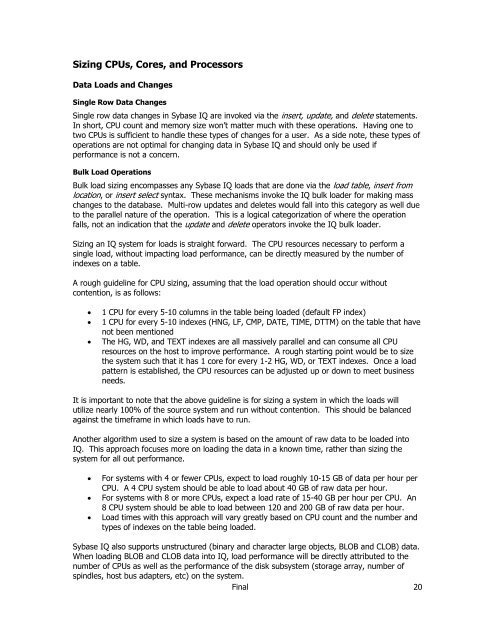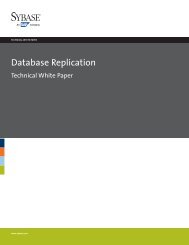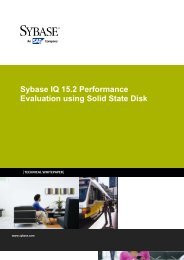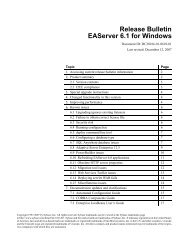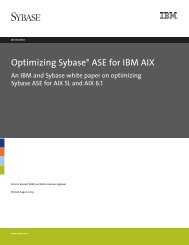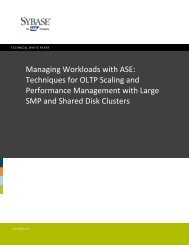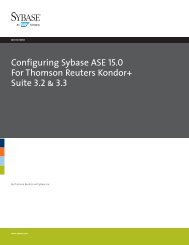A Practical Hardware Sizing Guide for Sybase IQ
A Practical Hardware Sizing Guide for Sybase IQ
A Practical Hardware Sizing Guide for Sybase IQ
Create successful ePaper yourself
Turn your PDF publications into a flip-book with our unique Google optimized e-Paper software.
<strong>Sizing</strong> CPUs, Cores, and Processors<br />
Data Loads and Changes<br />
Single Row Data Changes<br />
Single row data changes in <strong>Sybase</strong> <strong>IQ</strong> are invoked via the insert, update, and delete statements.<br />
In short, CPU count and memory size won‟t matter much with these operations. Having one to<br />
two CPUs is sufficient to handle these types of changes <strong>for</strong> a user. As a side note, these types of<br />
operations are not optimal <strong>for</strong> changing data in <strong>Sybase</strong> <strong>IQ</strong> and should only be used if<br />
per<strong>for</strong>mance is not a concern.<br />
Bulk Load Operations<br />
Bulk load sizing encompasses any <strong>Sybase</strong> <strong>IQ</strong> loads that are done via the load table, insert from<br />
location, or insert select syntax. These mechanisms invoke the <strong>IQ</strong> bulk loader <strong>for</strong> making mass<br />
changes to the database. Multi-row updates and deletes would fall into this category as well due<br />
to the parallel nature of the operation. This is a logical categorization of where the operation<br />
falls, not an indication that the update and delete operators invoke the <strong>IQ</strong> bulk loader.<br />
<strong>Sizing</strong> an <strong>IQ</strong> system <strong>for</strong> loads is straight <strong>for</strong>ward. The CPU resources necessary to per<strong>for</strong>m a<br />
single load, without impacting load per<strong>for</strong>mance, can be directly measured by the number of<br />
indexes on a table.<br />
A rough guideline <strong>for</strong> CPU sizing, assuming that the load operation should occur without<br />
contention, is as follows:<br />
� 1 CPU <strong>for</strong> every 5-10 columns in the table being loaded (default FP index)<br />
� 1 CPU <strong>for</strong> every 5-10 indexes (HNG, LF, CMP, DATE, TIME, DTTM) on the table that have<br />
not been mentioned<br />
� The HG, WD, and TEXT indexes are all massively parallel and can consume all CPU<br />
resources on the host to improve per<strong>for</strong>mance. A rough starting point would be to size<br />
the system such that it has 1 core <strong>for</strong> every 1-2 HG, WD, or TEXT indexes. Once a load<br />
pattern is established, the CPU resources can be adjusted up or down to meet business<br />
needs.<br />
It is important to note that the above guideline is <strong>for</strong> sizing a system in which the loads will<br />
utilize nearly 100% of the source system and run without contention. This should be balanced<br />
against the timeframe in which loads have to run.<br />
Another algorithm used to size a system is based on the amount of raw data to be loaded into<br />
<strong>IQ</strong>. This approach focuses more on loading the data in a known time, rather than sizing the<br />
system <strong>for</strong> all out per<strong>for</strong>mance.<br />
� For systems with 4 or fewer CPUs, expect to load roughly 10-15 GB of data per hour per<br />
CPU. A 4 CPU system should be able to load about 40 GB of raw data per hour.<br />
� For systems with 8 or more CPUs, expect a load rate of 15-40 GB per hour per CPU. An<br />
8 CPU system should be able to load between 120 and 200 GB of raw data per hour.<br />
� Load times with this approach will vary greatly based on CPU count and the number and<br />
types of indexes on the table being loaded.<br />
<strong>Sybase</strong> <strong>IQ</strong> also supports unstructured (binary and character large objects, BLOB and CLOB) data.<br />
When loading BLOB and CLOB data into <strong>IQ</strong>, load per<strong>for</strong>mance will be directly attributed to the<br />
number of CPUs as well as the per<strong>for</strong>mance of the disk subsystem (storage array, number of<br />
spindles, host bus adapters, etc) on the system.<br />
Final<br />
20


